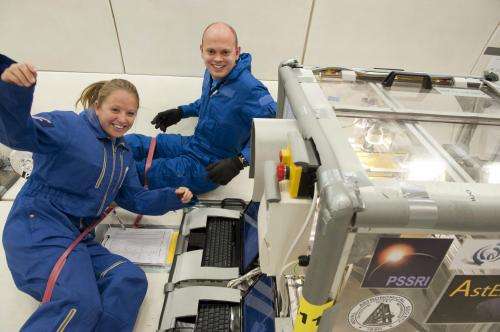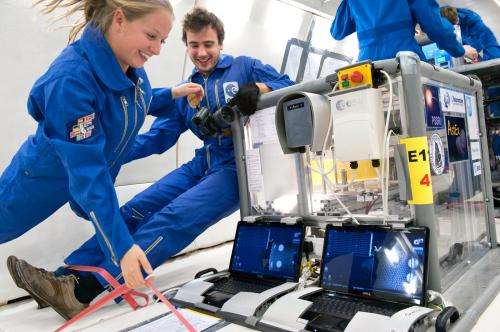Microgravity memory-test for granular materials suggests landing on asteroids may cause long-distance avalanches

(Â鶹ÒùÔº) —Results from a microgravity experiment suggest that the rubble and dust covering asteroids and comets can feel changes in force-chains between particles over much larger distances than on Earth, making these surfaces less stable than previously imagined. Dr Ben Rozitis of the Open University will present findings from the AstEx parabolic flight experiment at the National Astronomy Meeting in St Andrews on Thursday, 4 July.
"We see examples of force-chains everywhere. When you pick an orange from a pile in a supermarket, some come away easily but others bring the whole lot crashing down. Those weight-bearing oranges are part of a force-chain in the pile," said Dr Naomi Murdoch, a researcher at the Institut Supérieur de l'Aéronautique et de l'Espace in Toulouse. "One important aspect of such chains is that they give a granular material a 'memory' of forces that they have been exposed to. Reversing the direction of a force can effectively break the chain, making the pile less stable."
As a postgraduate students back in 2009, Rozitis and Murdoch took part in the European Space Agency's 'Fly your Thesis' campaign. They conducted experiments inside an Airbus A300, which flew in a series of parabolic manoeuvres that gave the students around 30 minutes of microgravity conditions. The Asteroid Experiment (AstEx) consisted of a cylinder filled with glass beads with a rotating drum at the centre. During several free-fall phases of the parabolic flights, AstEx's inner drum was spun for 10s and then the direction of rotation reversed. High-speed cameras imaged the top and bottom layers of beads through glass plates. After the flight, a particle-tracking programme was then applied to the images, and the behaviour of the beads analysed.

The AstEx experiment was designed by Murdoch, Rozitis, and colleagues from The Open University, the Côte d'Azur Observatory and the University of Maryland. AstEx data showed how chains of influence built up between beads when exposed to a force in one direction, and how those chains were disrupted when the force was reversed, both in microgravity and on Earth.
"Many smaller asteroids are thought to be entirely granular in nature – piles of rock and gravel held together by gravity. Understanding the physics of granular materials is important for interpreting spacecraft images of these small bodies, to understand their evolution, and also to help design space missions that will interact with their granular surfaces," said Murdoch. "AstEx allowed us to study the behaviour of grains in conditions that are similar to those encountered on the surfaces of asteroids and comets."
The team found that although particles close to the rotating surface of the drum were affected less in microgravity by the change in direction, those at the edge of the cylinder moved more than in the experiment on Earth. This implies that any changes to force-chains in low-gravity environments could be felt over much larger distances.

During their orbits, comets and asteroids may experience forces in a certain direction over long periods, for example during a planetary encounter or due to the rotation of the body. The AstEx findings suggest that an event like a meteorite impact or a spacecraft landing may have long-distance effects on the stability of regolith.
"A lander touching down on the surface on one side of a small, rubble-pile asteroid could perhaps cause an avalanche on the other side, by long-range transmission of forces through chains It would, however, depend on the angle and location of the impact, as well as the history of the surface – what kind of memories the regolith holds, " said Murdoch.
More information: A paper describing these results was published online on 27 May 2013 in the Monthly Notices of the Royal Astronomical Society: Simulating regoliths in microgravity N. Murdoch, B. Rozitis, S. F. Green, P. Michel, T.-L. de Lophem and W. Losert
Journal information: Monthly Notices of the Royal Astronomical Society
Provided by Royal Astronomical Society




















